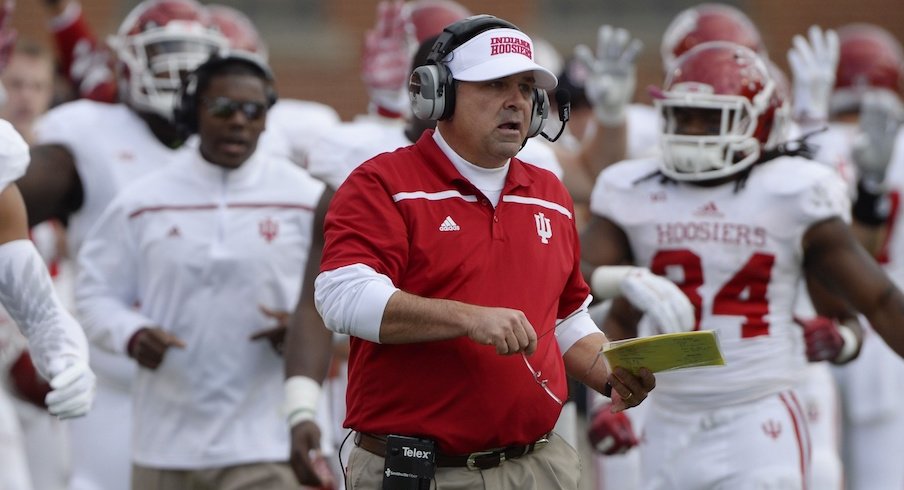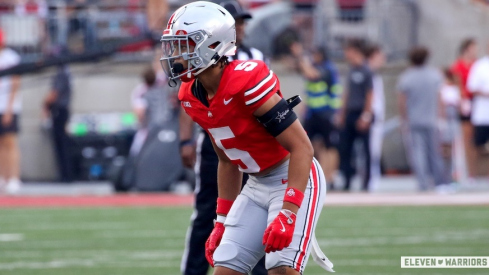“There's nothing that cleanses your soul like getting the hell kicked out of you.”
That profound statement from Woody Hayes rings true for Ohio State not even a week into its offseason. A 31-0 loss to Clemson in the Fiesta Bowl on New Year's Eve — largely due to a horribly underwhelming offense — forced Urban Meyer's hand and the head coach moved quickly.
| SEASON | SCHOOL | POSITION | TOTAL YPG | RANK |
|---|---|---|---|---|
| 2000 | NORTHWESTERN | OC/QB | 475.6 | 3rd |
| 2001 | NORTHWESTERN | AHC/OC/QB | 442.9 | 15th |
| 2002 | OKLAHOMA | Co-OC/OL | 392.6 | 37th |
| 2003 | OKLAHOMA | Co-OC/OL | 439.4 | 19th |
| 2004 | OKLAHOMA | Co-OC/OL | 462.1 | 8th |
| 2005 | OKLAHOMA | Co-OC/OL | 355.1 | 72nd |
| 2006 | OKLAHOMA | OC/TE/FB | 368.7 | 40th |
| 2007 | OKLAHOMA | OC/TE/FB | 448.9 | 19th |
| 2008 | OKLAHOMA | OC/TE/FB | 547.9 | 3rd |
| 2009 | OKLAHOMA | OC/TE/FB | 423.8 | 23rd |
| 2010 | OKLAHOMA | OC/TE/FB | 481.4 | 10th |
| 2011 | INDIANA | HC | 360.4 | 83rd |
| 2012 | INDIANA | HC | 442.0 | 34th |
| 2013 | INDIANA | HC | 508.5 | 9th |
| 2014 | INDIANA | HC | 405.0 | 64th |
| 2015 | INDIANA | HC | 504.3 | 14th |
| 2016 | INDIANA | HC | 426.0 | 56th |
Tim Beck left to be Tom Herman's offensive coordinator at Texas and Meyer replaced him with Ryan Day, who served as a graduate assistant for the head coach at Florida. And the program hired former Indiana head coach Kevin Wilson as its next offensive coordinator.
Meyer knew he had to make major changes following the stunning loss to the Tigers, the first time in his career his team failed to score a single point. The offensive regression the last two seasons was noticeable, namely in a lack of creativity from a play calling standpoint and struggles at the quarterback position. Even still, J.T. Barrett was named the Big Ten's Quarterback of the Year and shared the Silver Football as Big Ten MVP with Penn State's Saquon Barkley in 2016.
To fix what ails them, the Buckeyes turn to Wilson, who before he pieced together far less talented players at Indiana into terrific offenses, torched the Big 12 as Oklahoma's offensive coordinator. Before that, Wilson led a resurgent effort at Northwestern from 1999-2001. His final year in Evanston doubles as the first season Meyer received a head coaching position, at Bowling Green. Meyer honed his offense with a ton of the same principles as Wilson after sending an assistant to Northwestern to learn as much as he possibly could.
Meyer has often said how much he loves Wilson's work and what he did in Bloomington, morphing Indiana from a Big Ten doormat into a thorn in his side the last five seasons.
“For four years in a row it's been a swing as hard as you can [game],” Meyer said on Oct. 3, five days before Ohio State slugged its way to a 38-17 victory over the Hoosiers. “I think they got an excellent coaching staff and you can see some really positive, really good things on video tape.”
Wilson's offensive mindset revolves around tempo, but it revolves more around the players he has in place. Consider: his quarterbacks finished in the top five of the Big Ten in passing yards each of the last four seasons, Wilson had a player finish in the top three of the conference in receiving yards per game in four of his six seasons at Indiana and coached three 1,000-yard rushers (and one 2,000-yard rusher) during his time in Bloomington. The only times Indiana's offense finished outside the top three in the conference in total yards per game was 2014 when they were fifth at 405 yards per game and in 2011 when they finished eighth.
That is a bunch of offense. A bunch of points, too.
But how Wilson found success with lower rated prospects is what is important. Think back to the Ohio State-Indiana game from the 2016 season. This play brought the Hoosiers to within one possession of the Buckeyes in the third quarter and sent Ohio State fans into deep concern on Twitter, in Ohio Stadium and elsewhere.
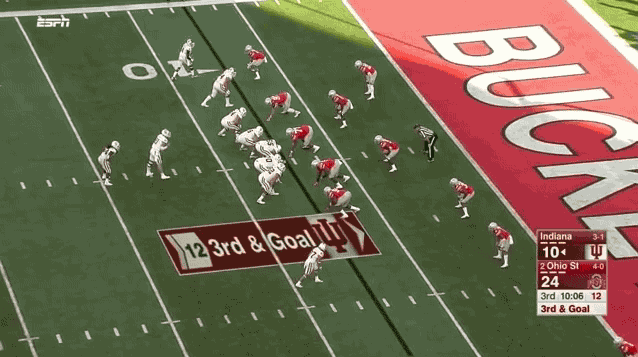
That is Richard Lagow (a quarterback who wears No. 21) selling a quick screen to Ricky Jones and hitting tight end Danny Friend for a wide open 7-yard touchdown pass. The Hoosiers set that play up earlier in the game on the other end of the field, when Wilson directed Lagow to throw it to the receiver on the screen. As you can see from above, Malik Hooker and Marshon Lattimore both jumped that route, Friend scored easily and Indiana got right back in the game after a well-executed 13-play, 89-yard drive.
Of note: that was one of seven passes Friend caught all season. Wilson knows how to use his personnel well and at the right time. He did something similar against Michigan State this season, telling his outside receiver to run a comeback route while the guy in the slot sped off on a wheel route behind him and caught a wide open touchdown pass.
Arguably the best player Wilson coached at Indiana was Tevin Coleman, a running back who torched the Buckeyes in 2014 for 228 yards and three touchdowns on 27 carries. Coleman ripped off a 90-yard touchdown in the third quarter, then busted off another 52-yard scoring scamper with under 90 seconds left for good measure.
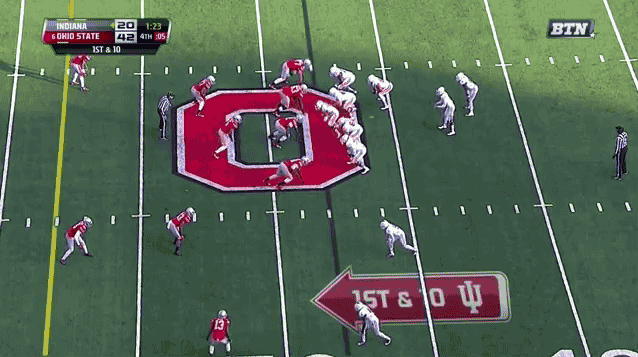
This is a great individual play by Coleman, but the scheme and play call helped immensely. Quarterback Zander Diamont checked to the sideline and audibled to this running play. Behind great blocks at the initial point of attack, Coleman had more than enough speed and agility to outrun Ohio State's secondary.
Meyer's spread offense is predicated on a strong downhill rushing attack and running backs with that kind of skill. Ezekiel Elliott had it. Carlos Hyde did too. Mike Weber isn't there yet. But who is to say he can't be if put in a spot where he can be successful?
Look at the formation on this play as opposed to the one above where Coleman splits defenders and scores a touchdown.
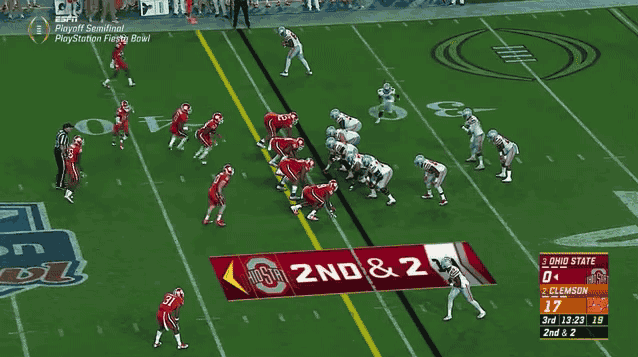
The fumble is inexcusable for Weber, though it could be looked at as a kid trying to make a play for his team that trailed by 17 points. Either way, you can see all 22 players on the field on the screen at the snap because Ohio State's wide receivers aren't even 10 yards out wide from tackles Isaiah Prince and Jamarco Jones. In the Coleman clip, the top receiver is out of the picture and the guys on the bottom are split out wider.
Ohio State tries to combat this against Clemson with presnap motion but it doesn't work. The middle of the field is clogged up, so even though the play is decently blocked safety Jadar Johnson is ready and waiting to hit Weber after a 5-yard gain. Another difference is the effort the wide receivers make on their blocks before Weber fumbles. Noah Brown and Terry McLaurin don't even touch the defensive backs in front of them, stopping after running 5 yards.
In the Coleman clip, the outside receiver at the bottom of the frame runs his guy off and the slot man at least attempts to throw a block on Darron Lee. That helps Coleman slip Lee's tackle and break out into the open. Coleman is an excellent player and on the Atlanta Falcons roster for a reason but Weber didn't even have much of a chance to do something similar because the personnel and design of the plays are considerably different.
Wilson can help with the design. Getting guys to block better at receiver and on the offensive line are different stories. But what is interesting is how Ohio State tried to use a similar formation later in the Fiesta Bowl to throw the ball. Spoiler: it didn't work either.
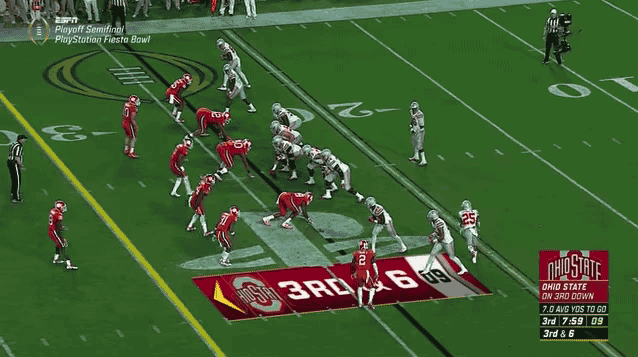
Another angle:
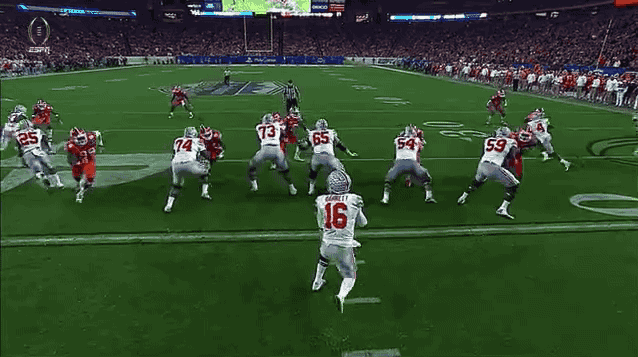
It doesn't help that Barrett had a free runner in his face as he tried to throw the ball but once the play starts you can see how every player on the field is in the frame. All that congestion hardly allows for playmakers — regardless how great they are — to find space and do much of anything.
Fans will complain about Barrett's regression the last two years under Tim Beck for good reason, but against Clemson, he hardly had time, as evident by the play above. Ohio State's line must be better moving forward. Its receivers must be better at creating separation. And the minds orchestrating the offense must be better moving forward at putting their players in places where they can succeed.
Tom Herman was a master at that. Ed Warinner and Tim Beck didn't reach Herman's standards, which is next to impossible even though that is the expectation following 2014's national championship run. Fans believe Ohio State's offense should look like that every year, as well as fast. That is why Meyer brought Herman to Columbus ahead of the 2012 season. Barrett thrived in tempo situations, where he didn't have to think much, make a quick read or two and go make plays.
Indiana averaged 79 plays per game over the last two seasons with Wilson running its offense, while the Buckeyes averaged 72 in the same span with the trio of Meyer, Warinner and Beck calling the shots. Ohio State slowly got away from tempo in 2015 much to their offensive line's chagrin. The Buckeyes all but abandoned it this year.
Using tempo keeps defenses from substituting. Ohio State in 2014 went with a certain set of skill guys (mostly a combination of Devin Smith, Michael Thomas, Evan Spencer, Jeff Heuerman, Nick Vannett, Jalin Marshall and Elliott) along with Barrett and put together one of the most potent and balanced offenses in the country. All of those players except for Barrett are now in the NFL, so the skill is certainly not at the same level.
But playing with tempo can help mask some shortcomings as long as it is used effectively and players like Samuel, Baugh, Weber and Noah Brown get the ball in space.
Wilson did a bunch with far less talented players in his six seasons in Bloomington than he will have to work with in Columbus as the next offensive coordinator. He helped put Coleman and Jordan Howard in the NFL and turned Cody Latimer, Simmie Cobbs Jr. and nearly Nick Westbrook into 1,000-yard receivers (Westbrook fell 5 yards short this season).
Who? Exactly.
The lack of defense from Wilson's teams prevented him from never enjoying a winning season at Indiana. But back-to-back 6-6 regular seasons with one of the Big Ten's most potent offenses is nothing to scoff at.
He did it by creating space, setting up plays for later in games and playing with tempo. There is a good chance that Meyer will stress playing to Barrett's strengths (and those of the rest of the offense) in order to grab yards and points in bunches in 2017.
